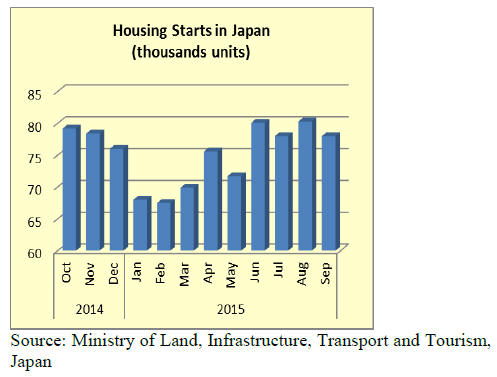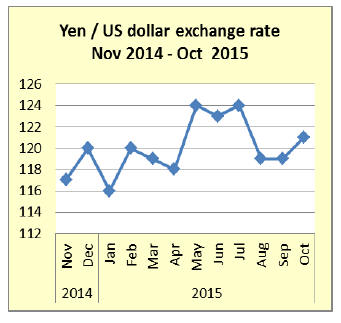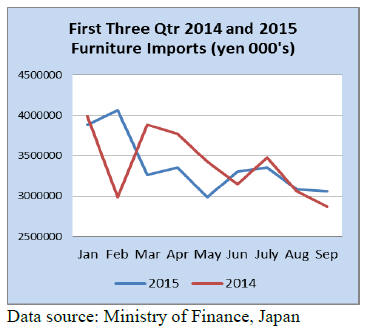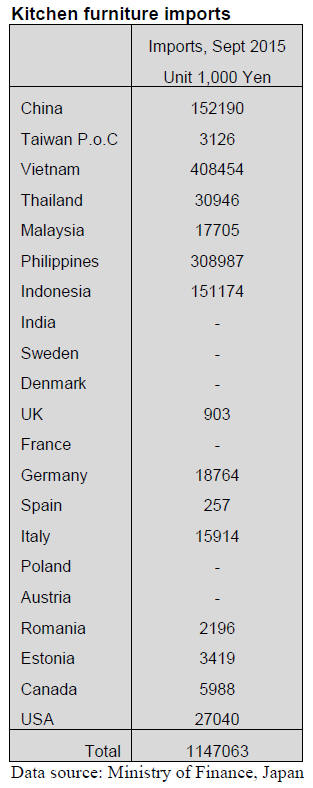Japan Wood Products
Prices
Dollar Exchange Rates of 25th
October 2015
Japan Yen 121.10
Reports From Japan
Manufacturing capacity exceeds output by an
increasing margin
In a mid-month report the Bank of Japan (BoJ) said that manufacturing
capacity exceeded output in the second quarter. The BoJ figures show that
the difference between available resources in the economy and their degree
of utilisation worsened in the second quarter.
The poor figures are expected to be repeated in the third quarter which
would pull Japan into a technical recession. The Bank’s own assessment of
the economy is that it has been weakening since May this year.
The fundamental problem, say analysts, is the economy will just not expand.
Japan’s economy is no bigger than it was in the mid-1990s mainly because of
a shrinking workforce.
More monetary easing? – not just yet
At its end of October policy meeting the Bank of Japan (BoJ), despite
being under pressure to introduce further stimulus measures, decided to wait
anticipating the negative sentiment created by the slowdown in growth in
China’s economy will dissipate. But many are calling for action by the Bank
as exports falter and housing growth slows.
September retail sales were weaker than expected, falling 0.2% from a year
earlier after five months of gains. This, along with the recent fall in
Consumer prices in the year to September and a decline in household
spending, is putting pressure on the BoJ to come with more stimulus
measures.
Poor September housing results
Japan's Ministry of Land, Infrastructure, Transport and Tourism has
released September housing start data showing a sharp, almost 2.5%, month on
month decline. Compared to levels in September 2014 the current data
reflects an 11% year on year fall. The current data is particularly worrying
as analysts had forecast a 6% increase in September.
The impact of the September starts drives down forecast annual 2015 starts
to below 930,000
The Ministry has also reported that orders placed with the large
construction companies in Japan continued the downward trend that saw August
orders fall by over 15%.
For more see:
http://www.e-stat.go.jp/SG1/estat/NewListE.do?tid=000001016966

More fixed rate home loans
There is now a trend amongst Japanese home buyers towards fixed rate loans
as they expect the BoJ monetary easing will eventually result in and
interest rate rise despite inflation being well below the BoJ’s 2% target.
Data from the Japan Housing Finance Agency show that 61% of recent new home
loans were with a fixed interest rate for at least five years, this is up
almost 40% from the time when floating interest rate loans were popular.
Home buyers in Japan are taking advantage of the current low interest rates
but anticipate rates will not drop further.
Construction industry shock
The Japanese real estate and construction sectors have been rocked by a
scandal surrounding structural flaws and falsified data for high rise
building across Japan.
The problem came to light when a condominium in Yokohama began to tilt,
apparently because foundation piles were inadequate. It was revealed that
the data supposed to confirm the piling work was falsified. Additional cases
of falsified piling data are coming to light.
There are now calls for independent third party checks to be made on
construction data submitted by contractors a move especially welcome in a
country that experiences frequent and occasionally massive earthquakes.
Yen/dollar rate hangs in neutral zone
The neutral stance adopted by the US Federal Reserve on interest rates
and the decision by the Bank of Japan to hold off on any further stimulus
measures has left the yen/dollar rate hanging in a 120/dollar range.
The yen received a boost in the second half of the month as nervous traders
shifted funds to yen as the US sailed a warship close to Subi Reef in the
Spratly Island chain where China claims sovereignty. In times of potential
crisis money flows into the yen as a ‘safe haven’ but this impact on
exchange rates was short lived.

Japan’s first three quarter furniture imports
Japan’s imports of office, kitchen and bedroom furniture in the first three
quarters of 2014 and 2015 exhibit a similar trend except for the sharp rise
in February 2015 when imports rose spurred on by the decision of the
government to raise the consumption tax by 3%.
Consumer spending on a whole range of goods jumped in the months prior to
the 1 April tax hike.

Office furniture imports (HS 940330)
Year on year September 2015 office furniture imports by Japan were down 11%
however, September 2015 imports were up 28% compared to August imports.
The top three suppliers in September were China, Portugal and Italy but
suppliers in Taiwan P.o.C slipped out of the top ranking in September.
Office furniture imports from China jumped a massive 60% in September
compared to a month earlier. Shippers in Portugal saw a modest increase but
imports from Italy remained at the same level as in August. The top three
supply countries accounted for 84% of all Japan’s office furniture imports
and if SE Asian supply countries are included then 90% of imports are
accounted for.

Kitchen furniture imports (HS 940340)
September 2015 imports of kitchen furniture remained steady at much the same
level as in August and were up 6.5% year on year.
The top three supply countries remain Vietnam, Philippines and China and
accounted for 75% of September kitchen furniture imports, down from the 85%
share in August. In September shipments from SE Asian supply countries
increased and captured a large share of total imports.
Kitchen furniture imports from EU suppliers remain small with only Germany
and Italy featuring in the import data.

Bedroom furniture imports (HS 940350)
Despite the rather gloomy housing and consumer spending data September 2015
imports of bedroom furniture were up 9% year on year. This was despite the
6% downward correction in September imports compared to those a month
earlier.
As has been the case for most of the year China and Vietnam account for the
bulk of Japan’s bedroom furniture imports (83% in September). Shippers in
Malaysia saw September exports to Japan rise and other SE Asian suppliers
could only manage to maintain exports to Japan at around the same levels as
in August.

Trade news from the Japan Lumber Reports (JLR)
For the JLR report please see:
http://www.n-mokuzai.com/modules/general/index.php?id=7
South Sea (tropical) logs
Things changed after two big log buyers, India and China pulled back.
India made big purchase of about two months logs in last July then became
inactive since then. Move by India, which buys about 60% of Sarawak log,
gives large impact in Sarawak log market. China is quiet and stopped
energetic log purchase by general economic slowdown in China.
By absence of two giants, log market in Sarawak is changing slightly. Small
diameter log prices weakened some since last August but supply of quality
large size logs continues tight. Also supply of kapur and keruing for lumber
is getting tighter and tighter. The prices for such quality logs stay up
high but there is some sign that the prices get softer by weak trend of
small diameter logs.
Sarawak meranti regular log prices are about US$290 per cbm FOB, US$265 for
small meranti and US$250 for super small meranti. Sabah enjoys fair weather
and log production is steady and the log prices are weaker with stable
quality than Sarawak so that Japanese log importers send more ships to Sabah.
Log export volume from Malaysia for the first eight months was 127,264 cbms,
19.2% less than the same period of last year.
Weather in PNG and Solomon Islands has been fair for about two months so log
production is steady The largest buyer, China is absent now but supply of
quality logs Japan wants is low so that the prices remain high.
August plywood supply
Total plywood supply in August was 419,000 cbms, 9% less than August
last year and 6.5% less than July.
This is seven straight month with the volume less than 500,000 cbms. The
reasons are record low import plywood supply and production curtailment by
domestic plywood mills.
Drastic decline of Indonesian supply made share of domestic supply over 50%.
Softwood plywood inventories decreased under 160,000 cbms.
Total imported plywood supply in August was 205,200 cbms, 17% less than
August last year and 11.9% less than July. This is the lowest monthly supply
this year and the lowest in about four years since September 2011.
Since last May, record low monthly import has continued for four consecutive
months with average monthly arrivals of 217,500 cbms, 24% less than the same
period of last year. Assuming this low level continues, total year import
would be about 2,790 M cbms, which is lower than past record low import in
2009 of 2,840,000 cbms.
Indonesian supply sharply dropped in August. 44,600 cbms in August was 39.8%
less and 46.9% less.
Monthly average volume from Indonesia from May through August was 63,800
cbms and July arrivals were 84,100 cbms so August decline is conspicuous.
Malaysian supply continues less than 90,000 cbms for four consecutive
months. Eight month’s total supply is 20.8% less than the same period of
last year. Chinese supply remains unchanged.
Domestic production in August was 213,800 cbms, almost no change from July.
Softwood plywood production was 198,500 cbms. Eight months total is 4.6%
less than last year. The shipment was 222,400 cbms, 15.1% more than last
year and 11.9% less than July. Eight months total was 5.5% more.
August inventory was 159,600 cbms, about 23,000 cbms less than July.

PEFC promotes use of certified wood for the Olympic
PEFC (Programme for the endorsement of forest certification schemes) Asia
Promotions (Tokyo) emphasizes importance of using certified wood products
for the 2020 Olympic Games in Tokyo.
The Promotions commented that greening trend of the Olympic Games has
steadily been spreading and in 2012 London Olympics, percentage of certified
wood materials was almost 100% and policy to use certified materials is
clearly shown in other Olympics.
Use of certified materials has started in 2010 for the Winter Olympics at
Vancouver, Canada. At this time, percentage of certified materials reached
50-70% then in 2012 London Olympics, procurement of certified materials was
designated and percentage of PEFC and FSC certified materials was 95-100%
for 12,500 cubic meters of wood.
For 2016 Rio de Janeiro Olympic, by procurement policy with sustainability
management report, wood and pulp used for the Games are designated certified
products by FSC and PEFC.
For the Tokyo Olympics, PEFC, FSC and SGEC agreed to keep appealing use of
certified materials in 2013 and to continue appeals to necessary
organizations. For London Olympics, standard was set for public procurement
of wood products, which says only materials guaranteed sustainability can be
used and made examination and evaluation on forest certification system. The
London Olympic committee set standard on sustainability for the building and
printed materials then made timber supply panel.
The materials were supplied by ones which can perform, selected by auction.
There were twenty major projects in the Olympic Park only then certified
materials were used for other facilities like Olympic Village, cycle race
facility, swimming facility and stadium benches.
Old Wood plans marketing hardwood flooring in Japan
Old Wood (New Mexico, U.S.A.) flooring manufacturer plans to market the
products in Japan. Presently it is looking for marketing partner in Japan.
It has four plants in New Mexico and one in Mexico and markets the products
not only in the U.S.A. but also for Europe, Middle East and Asia.
It manufactures from hardwood logs in the areas such as mesquite, white oak,
black walnut and Douglas fir. It has its own timberland of about 2,400
acres. Logs are procured from New Mexico, Arizona, Colorado and Texas.
It respects sustained yield base harvest and buys logs from native American
land and also gives technical guidance to the native Americans.
|